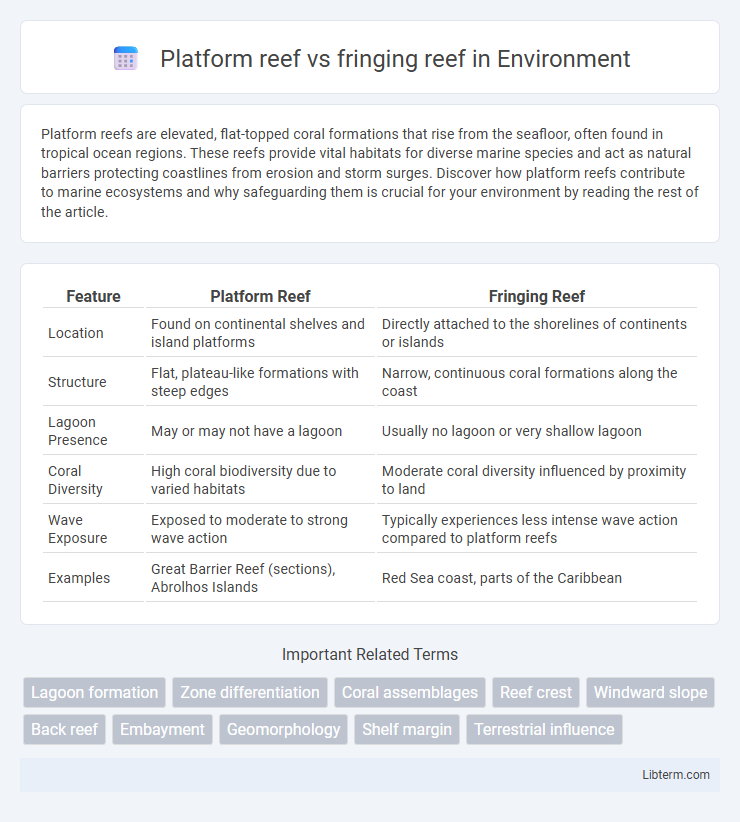Platform reefs are elevated, flat-topped coral formations that rise from the seafloor, often found in tropical ocean regions. These reefs provide vital habitats for diverse marine species and act as natural barriers protecting coastlines from erosion and storm surges. Discover how platform reefs contribute to marine ecosystems and why safeguarding them is crucial for your environment by reading the rest of the article.
Table of Comparison
| Feature | Platform Reef | Fringing Reef |
|---|---|---|
| Location | Found on continental shelves and island platforms | Directly attached to the shorelines of continents or islands |
| Structure | Flat, plateau-like formations with steep edges | Narrow, continuous coral formations along the coast |
| Lagoon Presence | May or may not have a lagoon | Usually no lagoon or very shallow lagoon |
| Coral Diversity | High coral biodiversity due to varied habitats | Moderate coral diversity influenced by proximity to land |
| Wave Exposure | Exposed to moderate to strong wave action | Typically experiences less intense wave action compared to platform reefs |
| Examples | Great Barrier Reef (sections), Abrolhos Islands | Red Sea coast, parts of the Caribbean |
Introduction to Platform Reefs and Fringing Reefs
Platform reefs are isolated, flat-topped coral formations resting on continental shelves, often found in shallow waters and supporting diverse marine ecosystems. Fringing reefs develop directly along coastlines, creating narrow coral bands that protect shorelines from wave erosion and provide habitats for numerous aquatic species. Both reef types play critical roles in coastal biodiversity and marine protection but differ in their location and structural characteristics.
Defining Platform Reefs
Platform reefs are flat-topped, isolated coral formations typically found on continental shelves, characterized by a broad base and lack of a strong backreef slope. Unlike fringing reefs that directly border shorelines with a narrow lagoon or backreef area, platform reefs develop away from the coast, often surrounded by deep water. These reefs support diverse marine ecosystems by providing extensive habitats on their elevated, submerged surfaces.
Defining Fringing Reefs
Fringing reefs are coral reefs that directly border a shoreline, forming a narrow strip separated from land by shallow lagoons or no lagoon at all. These reefs develop close to the coast, thriving in shallow waters with ample sunlight and nutrients from terrestrial runoff. Unlike platform reefs, which form on continental shelves or isolated offshore areas, fringing reefs are integral to shoreline ecosystems and play crucial roles in coastal protection and biodiversity support.
Key Structural Differences
Platform reefs, also known as atoll reefs, are typically circular or oval-shaped structures formed on submerged volcanic islands and feature a lagoon in the center. Fringing reefs directly border the shoreline, growing seaward with a narrow or no lagoon between the reef and land. Key structural differences include the presence of a central lagoon in platform reefs, compared to the continuous reef-to-shore connection found in fringing reefs.
Formation Processes of Platform Reefs
Platform reefs form through the gradual accumulation of coral growth on continental shelves or submerged banks, where stable sea levels and suitable substrates allow corals to expand horizontally. Unlike fringing reefs, which develop directly along coastlines, platform reefs grow detached from the shore, often creating isolated, flat-topped structures. Their formation is driven by a balance between coral growth rates, sediment deposition, and changes in sea level, enabling extensive carbonate buildup over time.
Formation Processes of Fringing Reefs
Fringing reefs form through the direct growth of coral colonies along coastlines, developing in shallow waters where sunlight penetrates easily, enabling symbiotic algae to thrive. These reefs typically originate from volcanic islands or continental shores, where corals colonize the substrate and gradually expand seaward, creating a narrow, continuous reef structure adjacent to the land. Sediment accumulation and wave action shape the reef's morphology, differentiating it from platform reefs, which often develop on submerged, flat carbonate platforms away from immediate coastal influence.
Geographic Distribution and Examples
Platform reefs primarily develop on continental shelves, commonly found in the Caribbean Sea and parts of the Pacific Ocean, with notable examples including the Great Barrier Reef's outer shelf platforms. Fringing reefs occur along coastlines in tropical regions such as the Red Sea, the Caribbean, and the Indian Ocean, directly attached to the shoreline or bordering islands, with significant examples like the reefs surrounding Zanzibar and the coast of Belize. Geographic distribution of platform reefs favors shallow, stable continental shelves, while fringing reefs flourish in nearshore environments with minimal tidal ranges.
Ecological Importance and Biodiversity
Platform reefs and fringing reefs both support high biodiversity but differ in ecological roles; platform reefs create extensive habitats on submerged flat seafloors, fostering diverse marine species including corals, fish, and invertebrates, while fringing reefs form close to shorelines, providing crucial coastal protection and nursery grounds for juvenile fish. Platform reefs contribute significantly to carbon cycling and nutrient dynamics due to their size and complexity, whereas fringing reefs enable sediment stabilization and buffer coastal ecosystems from wave damage. Both reef types enhance fisheries productivity and serve as indicators of marine ecosystem health, underpinning the resilience of coral reef biodiversity in tropical marine environments.
Human Impact and Conservation Challenges
Platform reefs face significant threats from coastal development and pollution due to their proximity to shorelines, leading to habitat degradation and sedimentation. Fringing reefs, directly adjacent to land, are highly vulnerable to runoff, overfishing, and tourism-related damage, which disrupt coral health and biodiversity. Conservation efforts prioritize reducing local stressors such as nutrient loading and implementing marine protected areas to enhance resilience and recovery of both reef types.
Conclusion: Comparing Platform and Fringing Reefs
Platform reefs develop on submerged shelves and exhibit diverse topographies supporting rich marine biodiversity, while fringing reefs form close to shorelines, acting as critical coastal barriers that protect land from erosion. Both reef types contribute significantly to marine ecosystems but differ in formation, habitat complexity, and ecological roles. Understanding these distinctions is essential for targeted conservation strategies and sustainable management of coral reef habitats globally.
Platform reef Infographic

 libterm.com
libterm.com